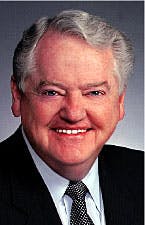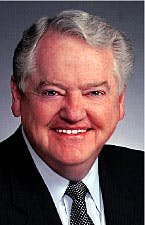Dean E. GaddyLow oil prices and the resulting merger mania in the oil industry are changing contract drilling markets, says Houston-based drilling contractor Global Marine Inc.
Drilling Editor
The firm's worldwide summary of current offshore rig economics (Score) fell nearly 30% during 1998. And the December Score revealed dayrate declines in all regions.
Global Marine President and CEO Bob Rose said, "The effect that (low oil prices) have had on the offshore rig fleet has been dramatic. After almost 10 years of steady improvements, today we have 125 (offshore) rigs stacked around the world."
Before the downturn, says Rose, typically 50 rigs were out of work at any given time, with most of these either in shipyards or in various stages of mobilization.
Global Marine's Score fell to 50.7% in December-a 9.6% decline from the previous month. Since December 1997, the worldwide Score has fallen 29%.
As of Dec. 31, 1998, average day- rates for Gulf of Mexico 250-ft jack ups fell to $17,000, a 70% drop from a year ago. West Africa 300-ft jack ups dropped to $30,000, a 63% decrease, and North Sea third-generation semisubmersibles fell to $80,000, a 52% drop.
However, worldwide dayrates for drillships, capable of drilling in 8,000 ft of water, have remained steady at $200,000, shedding positive light on the ongoing strength of the deep offshore market.
Shifting markets
Rose feels that major oil companies are likely to continue shifting exploration and production (E&P) investment away from the U.S., making the Gulf of Mexico even more dependent on smaller E&P companies, resulting in an even more volatile market for offshore drillers (OGJ, Dec. 7, 1998, p. 33)."Independents (quickly) spend their cash flow and turn their E&P programs on and off almost like a light switch," he said. In comparison, "Majors are like battleships and are slower to make changes in their plans."
The development of a new class of supermajors, consisting of BP Amoco plc, Exxon Mobil Corp., and Royal Dutch/Shell, will alter the offshore drilling customer base, predicts Rose.
According to Salomon Smith Barney, the top 3 major oil companies encompassed 38% of total E&P spending in 1995, out of a base group of 18 majors. In 1999, the top 3 majors are expected to account for 52% of total expenditures out of a base group of 16. Rose said that oil prices need to increase $2-3/bbl, into the $15/bbl range, before capital spending will increase. Even then, he predicts oil companies will be slow to respond, perhaps taking as long as a year before increased capital expenditures firmly take hold.
Offshore consolidation
Consolidation has been prevalent in the service-supply sector as well, where it has affected offshore rig ownership.In January 1990, the top three offshore drilling contractors controlled 31% of the premium jack ups and 32% of the floating rigs. In December 1998, the top three contractors controlled 43% of the premium jack ups and 44% of the floating rigs. Global Marine says the worldwide fleet now consists of 367 jack ups, 147 semisubmersibles, 25 drillships, and 9 barges and submersibles. By 2001, an additional 9 jack ups, 21 semisubmersibles, and 14 drillships are expected to join the fleet, for a total of 592 rigs.
Thirty-five out of the 44 new-builds are targeted for deepwater markets.
Size and scope
Rose believes that continued consolidation is necessary to meet future requirements of the industry."For the first time since 1992," said Rose, "most of the offshore drillers are trading below their underlying asset value. (Thus) rigs can be bought on Wall Street at one-third to two-thirds of replacement costs."
As of Jan. 8, Global Marine's price/ replacement value multiple was 0.55.
Rose said Global Marine continues to look for partners that will meet its criteria for "fleet quality, fleet balance, and financial stability." He declined to comment on possible negotiations.
"In order to take on the programs that the 'mega-majors' will have, in addition to those of the larger 'mega-independents,' we will have to have size and scope," explained Rose. "Size and scope allows us to have a larger R&D budget, better access to capital and markets, and will allow us to participate in projects that are much bigger (than otherwise possible). It also allows us to broker our own rigs," thus reducing the costs associated with moving rigs from market to market.
Bump-back program
Since the downturn that began last spring, Global Marine has cold-stacked two jack ups in West Africa. About 250 people were affected by this move, with the majority of the layoffs being African nationals.Rose remains somewhat optimistic, however: "We see no situation, given our current outlook, where we will have to be laying off people with skills that we desperately need."
Global Marine may even add personnel to its workforce with the addition of the C.R. Luigs rig in October 1999 and the Irish Sea in February 2000. About 150 workers are needed for each drillship. Global Marine uses two strategies to keep its expatriates working during downturns. If a rig goes idle, it moves its expatriates from that rig to a working rig. And it uses a "bump-back" program. "A bump-back program is when you take a toolpusher and bump him back to a driller, and so on," Rose said. "At the end of the day, what you lose in terms of core competency is the roustabout."
Company outlook
Despite the current downturn in oil prices, Rose feels confident about the long-term outlook for Global Marine. Its contract backlog remains strong, with expected revenues totaling $1.32 billion over the next 5 years.Global Marine reported its highest annual revenues ever at $1.16 billion, and its second-highest annual net income at $223.3 million in 1998. Since June 1997, Global Marine has added five deepwater rigs to its fleet.
Commenting on trend in the business, Rose stated, "I wish we could look forward to another record year in 1999, but, realistically, tougher times are ahead."
He says Global Marine will conserve cash until the market recovers by instituting hiring and wage freezes and selectively cold-stacking rigs that cannot find gainful employment.
Bob Rose Global Marine Inc. Pres. & CEO. In order to take on the programs that the 'mega-majors' will have, in addition to those of the larger 'mega-independents,' contract drillers will have to have size and scope. Size and scope allow us to have a larger R&D budget, better access to capital and markets, and will allow us to participate in projects that are much bigger.
Copyright 1999 Oil & Gas Journal. All Rights Reserved.


